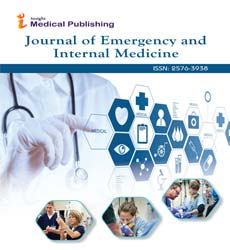ISSN : 2576-3938
Journal of Emergency and Internal Medicine
Synergistic Associations Between Arising Sicknesses
Anshula Ambasta*
Department of Medicine,University of Sherbrooke,Sherbrooke, Canada
- *Corresponding Author:
- Anshula Ambast
Department of Medicine,
University of Sherbrooke,
Sherbrooke,
Canada,
E-mail: AnshulaAmbast@hotmail.com
Received Date: July 5, 2021;Accepted Date: July 19, 2021; Published Date: July 26, 2021
Citation: Ambast A (2021) Synergistic Associations Between Arising Sicknesses. J Emerg Intern Med Vol.5 No : e002.
Description
An arising irresistible sickness (EID) is an irresistible infection whose frequency has expanded as of late (in the previous 20 years), and could increment sooner rather than later. Such infections don't regard public limits. The minority that are equipped for creating productive transmission between people can become significant public and worldwide worries as expected reasons for plagues or pandemics. Their numerous effects can be monetary and cultural, just as clinical. Arising contaminations represent essentially 12% of all human pathogens. EID can be brought about by recently recognized organisms, including novel species or strains of virus(e.g. novel Covids, ebolaviruses, HIV). Some EIDs advance from a referred to microorganism, as happens with new strains of flu. EIDs may likewise result from spread of a current sickness to another populace in an alternate geographic locale, as happens with West Nile fever flare-ups. Some realized illnesses can likewise arise in regions going through ecologic change (as on account of Lyme infection. Others can encounter a resurgence as a reappearing irresistible infection, such as tuberculosis(following drug opposition) or measles. Nosocomial (clinic procured) diseases, for example, methicillin-safe Staphylococcus aureus are arising in clinics, and are incredibly risky in that they are impervious to numerous anti-toxins. Of developing concern are unfavorable synergistic associations between arising sicknesses and other irresistible and non-irresistible conditions prompting the advancement of novel syndemics. Numerous EID are zoonotic, getting from microbes present in creatures, with just incidental cross-species transmission into human populaces. For example, most new infections are zoonotic (though other novel infections may have been flowing in the species without being perceived, as happened with hepatitis.
Concept of Emerging Diseases
The French specialist Charles Anglada (1809–1878) composed a book in 1869 on wiped out and new diseases. He didn't recognize irresistible sicknesses from others (he utilizes the terms receptive and emotional infections, to mean illnesses with an outer or inner reason, pretty much significance infections with or without a noticeable outside cause). He writes in the presentation
A broadly held assessment among doctors concedes the perpetual quality of pathologies. Every one of the diseases which have existed or which have an episode around us are arranged by captured and biased sorts, and should enter for sure into the systems set up by the nosologists. History and perception challenge this bias, and this is the thing that they instruct: Diseases which have vanished and whose follows are bound to the files of science, are trailed by different sicknesses, obscure to the contemporary age, and which come interestingly to affirm their privileges. All in all, there are wiped out and new sicknesses.
Charles Nicolle, laureate of the Nobel Prize in Physiology or Medicine explained the idea of development of sicknesses in his 1930 book "Naissance,Mort des Maladies Infectieuses" (Birth, Life and Death of Infectious Diseases), and later in Destin des ailments infectieuses distributed in 1933 which filled in as talk notes for his educating of a second year course at the Collège de France. In the presentation of the book he sets out the program of the talks. It is this chronicled presence, this fate that will be the subject of our discussions. I should reply, to the degree that our flow information permits, questions that you have asked yourself, that each smart or basically inquisitive brain inquires: have the irresistible infections that we notice today consistently existed? Or then again have some of them showed up throughout history? Would we be able to accept that new ones will show up? Would we be able to expect that a portion of these illnesses will vanish? Have some of them previously vanished? At last, what will happen to mankind and homegrown creatures if, because of an ever increasing number of incessant contacts between individuals, the quantity of irresistible infections keeps on expanding.
Open Access Journals
- Aquaculture & Veterinary Science
- Chemistry & Chemical Sciences
- Clinical Sciences
- Engineering
- General Science
- Genetics & Molecular Biology
- Health Care & Nursing
- Immunology & Microbiology
- Materials Science
- Mathematics & Physics
- Medical Sciences
- Neurology & Psychiatry
- Oncology & Cancer Science
- Pharmaceutical Sciences
